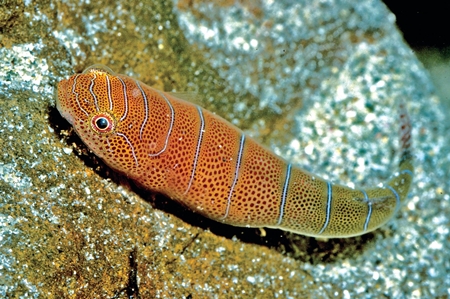General Description
Head broadly flattened, body tapering towards the tail; dorsal and anal fins short-based, set far back on body; tail base of moderate length, caudal fin rounded; pelvic fins united into a large sucking disc on the underside with a fleshy fringe on the posterior edge; snout very short, rounded when viewed from above. Head and body covered in close-set red and purple spots, with a series of blue lines or bands across the top and sides, tail greyish. To 4 cm.
Biology
These little fishes set up cleaning stations, clinging to larger fishes to remove their parasites. Although recorded from Port Phillip and Western Port in Victoria, the Western Cleaner Fish prefers deeper offshore reefs where it lives in caves, or in association with sponges and ascidians.
Habitat
Prefers caves in deeper offshore reefs, in depths of 5-40 m.
Reefs
Distribution guide
Southern Australia, including western and central Victoria.
Species Group
Fishes › Clingfishes and shore-eels
Depth
Shallow (1-30 m)
Deep ( > 30 m)
Water Column
Max Size
4 cm
Commercial Species
No
Global Dispersal
Native to Australia
Identify
Conservation Status
- DSE Advisory List : Not listed
- EPBC Act 1999 : Not listed
- IUCN Red List : Not listed





